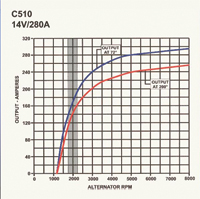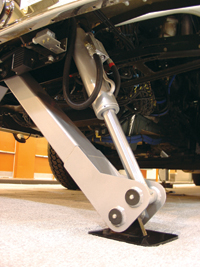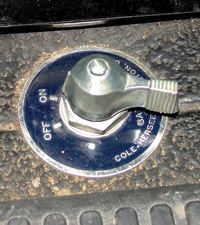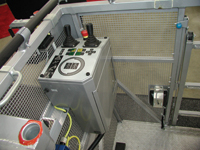
Equipment
Truck Checks: Apparatus 101 – part 2
Get out your study guides! This month’s Truck Check features the second half of the fire apparatus assessment exam. This set of questions picks up where our December issue left off, rounding out the section dealing with electrical objectives questions
February 5, 2009
By Don Henry
Get out your study guides! This month’s Truck Check features the second half of the fire apparatus assessment exam. This set of questions picks up where our December issue left off, rounding out the section dealing with electrical objectives questions before moving on to challenge your knowledge of NFPA 1901, aerials and transmissions. When you’ve completed the questions, be sure to visit www.granitefleet.com/answers to see how you did.
 |
|
| Question 52: Chart shows why alternator for fire apparatus must be rated at 200 F.
|
|
 |
|
| Question 57-58: Master battery disconnect switch.
|
|
 |
|
| Question 61-80: Stabilization cylinder for an aerial. | |
 |
|
| Question 79: A typical aerial platform control panel. |
■ Questions 41 to 47, dealing with electrical objectives, appeared in the December issue.
48. Wire resistance is affected by:
a. The length of the wire
b. The diameter of the wire
c. The material the wire is made of
d. The temperature of the wire
e. All of the above
49. In a parallel circuit, adding more loads will:
a. Decrease circuit resistant
b. Increase circuit resistance
c. Have no effect
d. Depend on whether the load is AC or DC
50. On modern electronic engines, it may be possible to program into the computer an engine shut-down or derate if oil or water temperature gets too high or oil pressure gets too low. For fire apparatus these devices
a. Must be enabled
b. May be enabled
c. May be disabled
d. Must be disabled
■ These questions deal with 1901 NFPA Standard for electrical systems on fire apparatus.
51. Total continuous load refers to:
a. Any load needed to operate the truck
b. Only loads that can be simultaneously connected
c. Does not include intermittent type loads like primers and hose rewinders
d. Only the loads needed at the fire scene
e. Both B and C
52. Alternators for fire apparatus must be rated to perform at what ambient temperature within the engine compartment?
a. 93 C (200 F)
b. 72 C (162 F)
c. 55 C (131 F)
d. 45 C (113 F)
e. Same as cars
53. A low-voltage warning device must be used; at what minimum voltage for a 12-volt system must this device produce an audible warning?
a. 10 volts
b. 11.2 volts
c. 11.8 volts
d. It’s adjustable to any voltage
54. The battery system will be able to restart the engine after providing the minimum continuous electrical load for at least how many minutes with the engine off?
a. Five minutes
b. 10 minutes
c. 15 minutes
d. 20 minutes
55. Wiring, switches, relays, terminals, and connectors must not be undersized to ensure these 12-volt systems on fire apparatus must be rated for:
a. 100 per cent of load
b. 115 per cent of load
c. 125 per cent of load
d. 150 per cent of load
56. It is very important that an alternator be correctly sized for the loads that will be placed on it. Who should review and analyze the maximum current output of the alternator to ensure it is of the correct size?
a. The purchaser
b. The truck manufacturer
c. The alternator manufacturer
d. The engine manufacturer
57. Master disconnect devices are used to prevent accidental
battery discharge. They:
a. Must be able to handle the full battery current that runs the engine starter
b. Are connected between the starter solenoid and the remainder of the electrical loads; batteries are connected directly to the starter solenoids
c. Stop all current flow to the ECMs on both the engines and transmission
58. The alternator must be connected to the batteries through the master disconnect device.
a. True
b. False
59. The use of star washers for circuit ground connections is permitted.
a. True
b. False
60. The following gauges and instruments must be on the pump operator’s panel with the exception of:
a. Engine oil pressure
b. Engine water temperature
c. Voltmeter
d. Engine tachometer
e. Engine oil temperature
■ These questions deal with aerials.
61. Define the term “ironing” in regard to aerial devices.
a. Grading of the base rail
b. Scoring of the base rail
c. Damage in the form of wear or indentations caused to the
bottom of the aerial device base rail
d. Smoothing of the base rail
62. The use of Liquid Penetrant Testing is to detect:
a. Surface cracks
b. Sub-surface voids
c. If the metal has been overheated
d. Can be used on metals and wood
63. Hydraulic pumps produce:
a. Pressure
b. Heat
c. Flow
64. If a hydraulic system on an aerial device works slower than normal, it is a:
a. Flow problem
b. Pressure problem
65. After bedding the aerial, the outriggers will not retract. The most likely causes are:
a. PTO has disabled
b. Hydraulic level low
c. Hydraulic oil too hot
d. Outrigger interlock is defective
e. Complete failure of the directional control valve that works the outriggers
66. A broken bolt in a turntable has been found during a routine inspection. After replacing the broken bolt and determine why the bolt failed, you should:
a. Re-torque all the bolts
b. Re-torque all the bolts to 20 per cent higher
c. Replace only the defective bolt
d. Replace with a grade lower bolt
67. When replacing a hydraulic hose, your first and most important consideration must be the:
a. Colour
b. Pressure rating
c. Length
d. Type of fittings
68. A fire station reports that an aerial platform cannot operate both its platform and lower controls at the same time.
a. This is an obvious failure of a flow proportional system control
b. This is normal
c. This is a failure of the override system; the aerial platform must be able to operate the stabilizer
69. High quality hydraulic hoses have a stripe on the outside of the hose. What is this stripe for?
a. Information on pressure rating
b. Information on hose size
c. Information on numbers of wire braids
d. To tell the installer if the hose is twisted after installation
70. When selecting a hydraulic filter, what is the first and most important concern?
a. Cost
b. Color
c. Micron size rating
d. Flow rating
■ These questions deal with NFPA 1901, 2009 Edition.
71. A small gasoline engine, diesel engine or electric motor-driven hydraulic pump is used to operate an aerial device in an emergency, or in lieu of a failure of the main hydraulic system.
a. True
b. False
72. Define the term “dead load”.
a. The weight of the water in the aerial piped waterway
b. The weight of the aerial device structure and all materials, components, mechanisms, or equipment permanently fastened
c. The weight of only the dead people you may have in or on the aerial
d. None of the above definitions are correct
73. Define the term “live load”.
a. Only the weight of the living people
b. Forces acting on the aerial device from personnel, portable equipment, water, and nozzle reaction
c. Any weight of the wind against the aerial
74. When calculations are done for the rated capacity of an aerial, the waterway (piping) is:
a. Not taken into account for the calculations
b. Is taken in account
c. Is taken in account but at no pressure
75. What is the NFPA standard for testing of aerial devices?
a. 1902
b. 1904
c. 1911
d. 1914
76. The manufacturer (contractor) must supply a minimum number of ladders. What is the minimum overall combined length?
a. 41 metres (135 feet)
b. 35 metres (115 feet)
c. 30.5 metres (100 feet)
d. 47 metres (155 feet)
77. Aerials rated at 34 metres (110 feet) or less must be raised from the bed to maximum elevation and rotated 90 degrees in a minimum of:
a. 60 seconds
b. 90 seconds
c. 120 seconds
d. 160 seconds
78. The rated capacity of the outermost rung (fly section) of an aerial without a piped waterway is:
a. 114 kg (250 lbs)
b. 150 kg (330 lbs)
c. 100 kg (220 lbs)
d. 250 kg (551 lbs)
79. To ensure operational controls are the same on all aerials, there is a certain order from left to right of the aerial hydraulic lever controls. From left to right, they are:
a. Extension, rotation, elevation
b. Rotation, elevation, extension
c. Elevation, rotation, extension
d. Elevation, extension, rotation
80. When electric over hydraulic aerial device controls are incorporated, a readily accessible, manual means of overriding the electric controls shall be provided.
a. True
b. False
■ These questions deal with the Allison objectives and the older mechanical hydraulic transmissions.
81. A typical Allison transmission model is the MT 653. This
transmission has:
a. Six forward ranges
b. Five forward ranges
c. Three forward ranges
82. On the model HT 750 Allison, when used with a diesel engine, how was throttle position sensed?
a. Throttle position sensor (TPS)
b. Output shaft speed sensor
c. Governor pressure
d. Modulator valve
83. When conducting a stall test on an Allison transmission, it was found to have a stall speed 300 r.p.m. higher than normal. This was caused by:
a. Cold oil
b. Plugged fuel filter
c. Plugged air filter
d. Slipping clutch plates
84. What is the purpose of the lock-up feature in the torque converter?
a. To improve fuel economy
b. To increase torque to the differential
c. To allow a lower gear when starting out from the curb
d. To allow for a smoother shift
85. What is the purpose of the modulated lock-up valve?
a. To allow for faster upshifts
b. To allow the lock-up clutch to stay on longer and, therefore, better engine braking when approaching a stop
c. For better fuel economy
d. A smoother low idle speed
86. The output shaft governor is matched to what other part in the transmission?
a. The valve body
b. The throttle position sensor
c. The output shaft gear
d. The range selector
87. How is the governor valve body marked for identification?
a. Letters stamped on the head
b. Numbers stamped on the head
c. Numbers inked on the head
d. Sorry, not marked in any way, they are interchangeable
88. The common oil for an Allison transmission is an ATF fluid, such as Dextron or Mercon. What other rating of oil can be used?
a. Motor oil
b. Hydraulic oil
c. Vegetable oil
d. C-4
89. If the transmission oil was too high on the dipstick (overfull), what would the effect be?
a. Harsh upshifts
b. Transmission overheating
c. Hard engine starts
d. Harsh downshifts
■ These questions refer to the newer electronic Allison transmission (WT).
90. The WT Allison transmission can store up to:
a. Four trouble codes
b. Five trouble codes
c. Six trouble codes
d. An unlimited number of trouble codes
91. The secondary shift schedule can be accessed:
a. by pressing both shift up and down buttons at once
b. by the ode button on the shift tower
c. Simply by hard acceleration
d. Only with a pro-link type tool
92. In which range(s) will the WT be in overdrive?
a. Fourth range
b. Fifth range
c. Sixth range
d. Fifth and sixth ranges
93. In which range is the WT when pumping water at a fire scene?
a. Fourth range
b. Fifth range
c. Sixth range
d. It depends which gear the driver selected
94. The WT transmission can adjust to driving changes and
normal wear inside the transmission. This is called:
a. Adaptive learning
b. Smart shift
c. Learn as you go
d. FFP (firefighter proof)
95. The retarder accumulator is located on the WT:
a. In the retarder housing
b. Under access covers on the bottom of the transmission sump
c. In a remote location on the frame rails or cross members
d. Inside the transmission
96. The Vehicle Interface Module (VIM) for an electronic transmission contains fuse(s) for:
a. Ignition and ECU power
b. Ignition and throttle position sensor (TPS)
c. Fire pumps controls and air conditioning
97. Engine coolant (glycol) has been detected in the transmission oil. The recommended service is:
a. Drain the transmission oil, replace all filters and drive
b. Remove and rebuild the transmission
c. Do not do anything and see what happens, maybe it will get better
d. Drain and flush, then sell to rural department
98. How many clutches must be applied for a forward range?
a. Two
b. One
c. Depends on the range selected
d. Three
99. The torque converter is made up of three major components.
a. Turbine, pump and lock-up
b. Turbine, pump and stator
c. Carrier, pump and stator
d. Lock-up, stator and impeller
100. Transmission oil pressure is highest during:
a. First range
b. Reverse range
c. Lock-up
d. High range
Don Henry teaches in the Automotive Services Technician and Heavy Equipment Technician programs at Lakeland College in Vermilion, Alta. He can be reached at don.henry@lakelandcollege.ca
Print this page